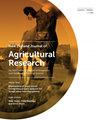新西兰三个奶山羊农场的临床跛行患病率和发病率
IF 1.5
3区 农林科学
Q2 AGRICULTURE, MULTIDISCIPLINARY
New Zealand Journal of Agricultural Research
Pub Date : 2023-10-18
DOI:10.1080/00288233.2023.2267516
引用次数: 0
摘要
临床跛行对不同畜牧业的动物福利和盈利能力都有影响。本研究的目的是估计新西兰奶山羊农场中临床跛行的患病率和发病率。对三个奶山羊养殖场的3246只山羊进行了每年4-5次的观察。在2019年6月至2020年6月期间收集了运动得分和动物信息的数据。采用5分(0-4分)运动评分量表,其中3分和4分为临床跛行。A、B和C农场的临床跛行的平均群水平患病率分别为23%、12%和10%。A、B和C农场的临床跛行年发病率分别为每100只山羊年104、56和55例。跛行似乎是一个重大的福利问题,不同农场和山羊之间的发病率不同。调查农场水平和山羊水平的因素是了解跛行流行病学和设计循证控制和预防措施的必要条件。应进行进一步的调查,以确定影响山羊临床跛行几率的变量。本研究为今后国内外商业化奶山羊养殖场的跛羊研究奠定了基础。本文章由计算机程序翻译,如有差异,请以英文原文为准。
Prevalence and incidence rate of clinical lameness in three New Zealand dairy goat farms
Clinical lameness has an impact on animal welfare and profitability in different livestock industries. The objective of this study was to estimate the prevalence and incidence rate of clinical lameness within New Zealand dairy goat farms. Up to 3246 goats on three dairy goat farms were observed 4–5 times over one year. Data on locomotion scores and animal information were collected between June 2019 and June 2020. A 5-point (0–4) locomotion scoring scale was used, where scores 3 and 4 were classified as clinical lameness. The average herd-level prevalence of clinical lameness for farms A, B, and C were 23, 12, and 10%, respectively. The annual incidence rate of clinical lameness for farms A, B, and C were 104, 56, and 55 cases per 100 goat-years, respectively. Lameness appears to be a significant welfare issue, with incidence varying between farms and between goats. Investigating both farm-level and goat-level factors is required to understand the epidemiology of lameness and design evidence-based control and prevention measures. Further investigation should be undertaken to identify variables affecting the goat's odds of becoming clinically lame. This study sets the foundation for future study of lameness in commercial dairy goat farms nationally and internationally.
求助全文
通过发布文献求助,成功后即可免费获取论文全文。
去求助
来源期刊
CiteScore
4.90
自引率
16.70%
发文量
31
审稿时长
3 months
期刊介绍:
The New Zealand Journal of Agricultural Research publishes original research papers, review papers, short communications, book reviews, letters, and forum articles. We welcome submissions on all aspects of animal and pastoral science relevant to temperate and subtropical regions. The journal''s subject matter includes soil science, fertilisers, insect pests, plant pathology, weeds, forage crops, management systems, agricultural economics, agronomy, and animal science. The journal also accepts crossover papers on subjects such as land –water interactions.

 求助内容:
求助内容: 应助结果提醒方式:
应助结果提醒方式:


